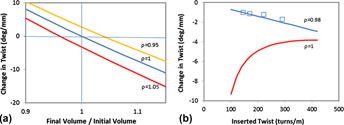Crossref Citations
This article has been cited by the following publications. This list is generated based on data provided by
Crossref.
Haines, Carter S.
and
Niemeyer, Gunter
2018.
Closed-Loop Temperature Control of Nylon Artificial Muscles.
p.
6980.
Tawk, Charbel
in het Panhuis, Marc
Spinks, Geoffrey M.
and
Alici, Gursel
2018.
Bioinspired 3D Printable Soft Vacuum Actuators for Locomotion Robots, Grippers and Artificial Muscles.
Soft Robotics,
Vol. 5,
Issue. 6,
p.
685.
Aziz, Shazed
Naficy, Sina
Foroughi, Javad
Brown, Hugh R.
and
Spinks, Geoffrey M.
2018.
Twist–coil coupling fibres for high stroke tensile artificial muscles.
Sensors and Actuators A: Physical,
Vol. 283,
Issue. ,
p.
98.
Huang, Yi-Wei
Lee, Wen-Shin
Yang, Fuqian
and
Lee, Sanboh
2019.
Tensile deformation of artificial muscles: Annealed nylon 6 lines.
Polymer,
Vol. 177,
Issue. ,
p.
49.
Shepherd, David J.
and
Spinks, Geoffrey M.
2019.
Double Helix Actuators.
Advanced Materials Technologies,
Vol. 4,
Issue. 1,
Tawk, Charbel
Spinks, Geoffrey M.
in het Panhuis, Marc
and
Alici, Gursel
2019.
3D Printable Linear Soft Vacuum Actuators: Their Modeling, Performance Quantification and Application in Soft Robotic Systems.
IEEE/ASME Transactions on Mechatronics,
Vol. 24,
Issue. 5,
p.
2118.
Spinks, Geoffrey M.
Bakarich, Shannon E.
Aziz, Shazed
Salahuddin, Bidita
and
Xin, Hai
2019.
Using force-displacement relations to obtain actuation parameters from artificial muscles.
Sensors and Actuators A: Physical,
Vol. 290,
Issue. ,
p.
90.
Sonseca, Agueda
Sahay, Rahul
Stepien, Karolina
Bukala, Julia
Wcislek, Aleksandra
McClain, Andrew
Sobolewski, Peter
Sui, XiaoMeng
Puskas, Judit E.
Kohn, Joachim
Wagner, H. Daniel
and
El Fray, Miroslawa
2020.
Architectured helically coiled scaffolds from elastomeric poly(butylene succinate) (PBS) copolyester via wet electrospinning.
Materials Science and Engineering: C,
Vol. 108,
Issue. ,
p.
110505.
Aziz, Shazed
and
Spinks, Geoffrey M.
2020.
Torsional artificial muscles.
Materials Horizons,
Vol. 7,
Issue. 3,
p.
667.
Aziz, Shazed
Martinez, Jose G.
Foroughi, Javad
Spinks, Geoffrey M.
and
Jager, Edwin W. H.
2020.
Artificial Muscles from Hybrid Carbon Nanotube‐Polypyrrole‐Coated Twisted and Coiled Yarns.
Macromolecular Materials and Engineering,
Vol. 305,
Issue. 11,
Karami, Farzad
Wu, Lianjun
and
Tadesse, Yonas
2020.
Modeling of One-ply and Two-ply Twisted and Coiled Polymer (TCP) Artificial Muscles.
IEEE/ASME Transactions on Mechatronics,
p.
1.
Salahuddin, Bidita
Warren, Holly
and
Spinks, Geoffrey M
2020.
Thermally actuated hydrogel bead based braided artificial muscle.
Smart Materials and Structures,
Vol. 29,
Issue. 5,
p.
055042.
Bhatti, Muhammad Rehan Asghar
Bilotti, Emiliano
Zhang, Han
Varghese, Shaji
Verpaalen, Rob C. P.
Schenning, Albert P. H. J.
Bastiaansen, Cees W. M.
and
Peijs, Ton
2020.
Ultra-High Actuation Stress Polymer Actuators as Light-Driven Artificial Muscles.
ACS Applied Materials & Interfaces,
Vol. 12,
Issue. 29,
p.
33210.
Kongahage, Dharshika
Spinks, Geoffrey M.
and
Foroughi, Javad
2021.
Twisted and coiled multi-ply yarns artificial muscles.
Sensors and Actuators A: Physical,
Vol. 318,
Issue. ,
p.
112490.
Salahuddin, Bidita
Warren, Holly
and
Spinks, Geoffrey M
2021.
A comprehensive test method for measuring actuation performance of McKibben artificial muscles.
Smart Materials and Structures,
Vol. 30,
Issue. 4,
p.
045016.
Nishimura, Yasuhiro
and
Spinks, Geoffrey M.
2022.
Detailing the visco‐elastic origin of thermo‐mechanical training of twisted and coiled polymer fiber artificial muscles.
Journal of Polymer Science,
Vol. 60,
Issue. 8,
p.
1360.
Ji, Yuhan
Chen, Weihai
Zhang, Jianbin
Li, Zhongyi
Fang, Zaojun
and
Yang, Guilin
2022.
Self-Identification of Cable-Driven Exoskeleton Based on Asynchronous Iterative Method.
Journal of Mechanisms and Robotics,
Vol. 14,
Issue. 2,
Grellmann, Henriette
Lohse, Felix M
Kamble, Vikram G
Winger, Hans
Nocke, Andreas
Hickmann, Rico
Wießner, Sven
and
Cherif, Chokri
2022.
Fundamentals and working mechanisms of artificial muscles with textile application in the loop.
Smart Materials and Structures,
Vol. 31,
Issue. 2,
p.
023001.
Bhatti, Muhammad Rehan Asghar
Kernin, Arnaud
Tausif, Muhammad
Zhang, Han
Papageorgiou, Dimitrios
Bilotti, Emiliano
Peijs, Ton
and
Bastiaansen, Cees W. M.
2022.
Light‐Driven Actuation in Synthetic Polymers: A Review from Fundamental Concepts to Applications.
Advanced Optical Materials,
Vol. 10,
Issue. 10,
Jafari Horastani, Sahar
Ghane, Mohammad
and
Karevan, Mehdi
2022.
Production and performance of a low temperature shape-memory actuator based on twisted-coiled spring mechanics.
Smart Materials and Structures,
Vol. 31,
Issue. 10,
p.
105005.



